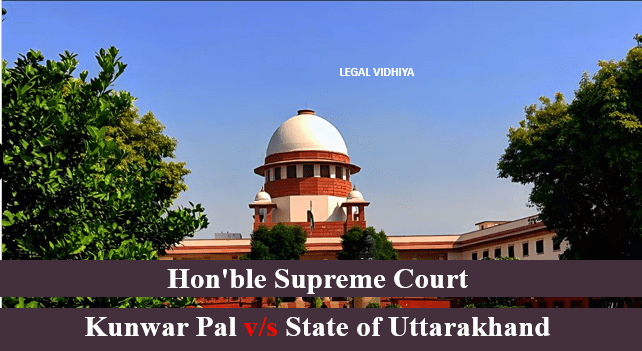
| Citation | CRIMINAL APPEAL NO. 1643 OF 2013 |
| Date of Judgement | 8 October, 2013 |
| Court | Supreme Court |
| Appellant/Petitioner/Plaintiff | Kunwar Pal |
| Respondents/Defendant | The State of Uttarakhand |
| Bench | B.S. Chauhan, S.A. Bobde |
FACTS-
- On May 22, 1998, the event happened in the courtyard (aangan) of the home of Shyam Sunder, the bride’s father, where approximately 30 guests were there to witness the wedding ceremony and another 60 people were outside the home enjoying refreshments.
- The appellant was perched on a trunk box in the verandah on one side of the courtyard. Hanuman Prasad, Ram Sewak, Mangal Singh, and the appellant Kunwar Pal were the four people who brought double barrel firearms, purportedly for a celebration.
- They were forbidden from firing by Ramayan Prasad, but they disregarded his advice. Unsafe fire resulted in a bullet striking the deceased’s neck, causing him to fall. A Tractor Trolley was used to transport the corpse to Gadarpur Government Hospital, where a doctor pronounced him dead.
- Ram Sewak left his double barrel gun behind as he fled the area. Mangal Singh fled while carrying a double barrel rifle. The appellant and Hanuman Prasad did not flee.
- Following the investigation’s conclusion, a charge sheet was submitted under Section 304 read with Section 120-B IPC, identifying the appellant and one Hanuman Prasad.
ISSUE-
- Whether the accused is liable u/s 302 for murder ?
CONTENTIONS-
- The prosecution made no attempt, in the opinion of the appellant’s knowledgeable attorney, to connect the pistol the appellant was using with the fatal shot that killed Ramayan Prasad. An expert in ballistics was not contacted.
- Without inflicting more harm, it is said that if the appellant is to blame for the deceased’s death, it can only be attributed to a hasty and careless act as defined by Section 304A of the IPC.
- On the other hand, the prosecution’s knowledgeable counsel backed the conviction and punishment. The experienced attorney claims that it is shown that the appellant was in possession of a pistol and had shot it. He had no justification for bringing a pistol to a wedding reception, and it has been correctly determined that he did so exclusively with the purpose to murder.
JUDGEMENT-
- It is challenging to believe that the dead was the lone target of the appellant’s pistol when the shot that killed him was fired. Given that there were three other people in the ceremony shooting their guns, this assumes significance. Therefore, it is impossible to assign blame for the murder to the appellant, let alone assign blame for any purpose to intentionally cause the death of the deceased.
- In any event, the appellant is entitled to the benefit of doubt, which is important in this case, because it has not been established beyond a reasonable doubt that the appellant intended to kill the dead. As a result, the sentence imposed under Section 304 Part I of the IPC, which stipulates that the act by which death is caused must be done with the aim of causing death or such physical damage as is likely to cause death, cannot be upheld.
- Given that the act was performed with the knowledge that it was likely to result in death as defined by Section 304 Part II of the IPC, we believe that the appellant is responsible for the act in this case that resulted in the death of the deceased. Given the facts, we partially approve the appeal but shorten the term given to the appellant to 7 (seven) years without changing the fine amount set by the trial court and upheld by the High Court.
REFERENCES-
- Indiankanoon.com
- Casemine.com
This case analysis is written by Anshula Grover, intern at Legal Vidhiya and a student at Shoolini University.




0 Comments